The UMD small grain variety trial data are now available. Click here to view the report, or contact your local ag agent the Extension Office for a hard copy. Information is intended to help growers select the best wheat and barley varieties for the 2020 crop. Additional variety data on DON vomitoxin will be posted to this page soon.
Tag: wheat
FHB Update: May 10, 2019
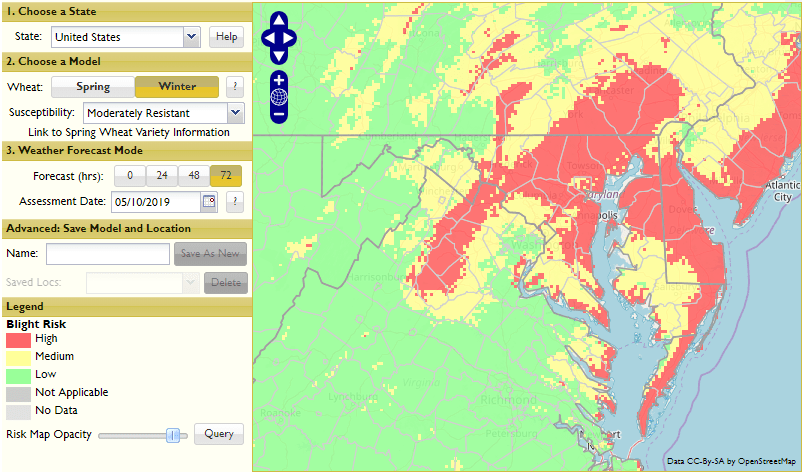
Wheat in the Eastern Shore of Maryland is finishing up flowering. The risk
for FHB is high. If you haven’t sprayed and you are still within 4-6 days
of flowering, you can still do so. Wheat in the Northern parts is heading
now and will soon start flowering. The FHB risk for this part of the state
is also predicted to be high, and the farmers should be prepared to spray
fungicides on their wheat when it flowers (50% of the main tillers showing
yellow anthers). The fungicides effective for FHB are Prosaro/ Caramba/
Miravis-Ace. The best stage recommended for spraying fungicides is early
flowering or within 4-5 days of that. These fungicides do not need to be
tank mixed with another product for spraying. The fungicide products should
be applied at the full rate recommended by the manufacturers. Strobilurin
containing fungicides should not be sprayed at this stage. Aerial
application at a rate of 5 gallons per acre or ground application at 15
gallons per acre with 300-350 um droplet size is recommended. Spray nozzles
should be angled at 30°-45° down from horizontal, toward the grain heads,
using forward- and backward mounted nozzles or nozzles with a two
directional spray, such as Twinjet nozzles. There has been no other major
disease being seen anywhere across the state in wheat so far.
–Nidhi Rawat, Small grains Pathologist, University of Maryland
For more details, go to the FHB Risk assessment tool at
http://www.wheatscab.psu.edu
For the latest news and updates from the U.S. Wheat & Barley Scab
Initiative, go to https://www.scabusa.org
FHB Update: May 3, 2019
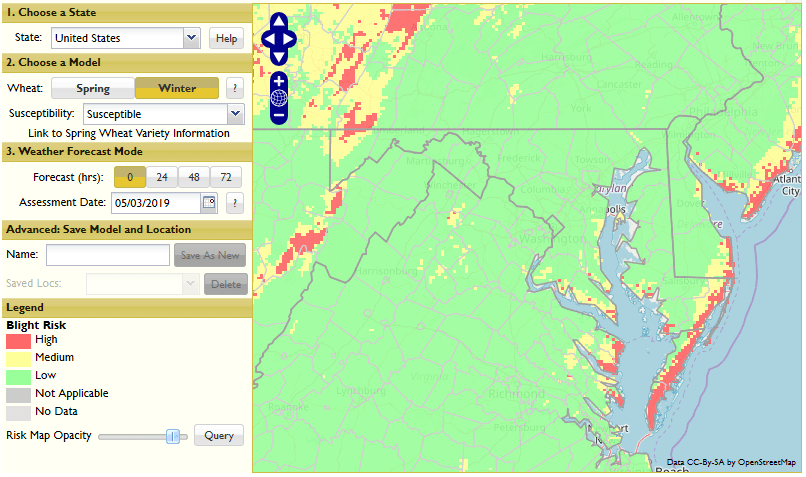
Wheat in the Eastern Shore of Maryland is beginning to flower or will do so
in a couple of days. With yesterday’s rains, and more showers coming our
way, the risk of Fusarium Head has increased significantly in this part of
the state. Growers with wheat flowering (50% of the main tillers showing
yellow anthers) are advised to spray head scab fungicides (Prosaro/ Caramba/
Miravis-Ace) at early flowering or within 4-5 days of this stage. These
fungicides do not need to be tank mixed with another product for spraying.
The fungicide products should be applied at the full rate recommended by the
manufacturers. Strobilurin containing fungicides should not be sprayed at
this stage. Aerial application at a rate of 5 gallons per acre or ground
application at 15 gallons per acre with 300-350 um droplet size is
recommended. Spray nozzles should be angled at 30°-45° down from
horizontal, toward the grain heads, using forward- and backward mounted
nozzles or nozzles with a two directional spray, such as Twinjet nozzles. Up
in the North wheat is booting, and still roughly around 2 weeks away from
flowering.
–Nidhi Rawat, Small grains Pathologist, University of Maryland
For more details, go to the FHB Risk assessment tool at
http://www.wheatscab.psu.edu
For the latest news and updates from the U.S. Wheat & Barley Scab
Initiative, go to https://www.scabusa.org
Checklist For Head Scab Fungicide Applications
Andrew Kness, Agriculture Agent
University of Maryland Extension, Harford County
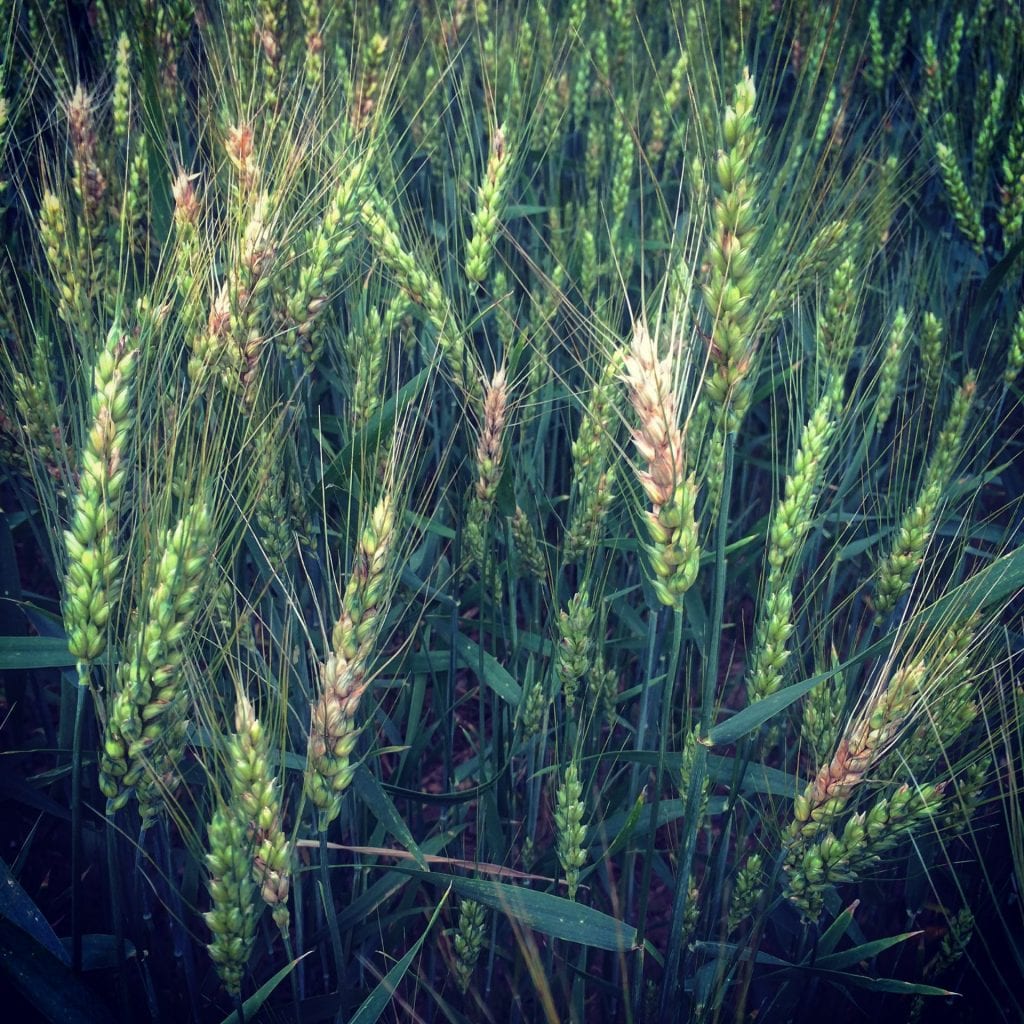
Wheat in the southern parts of Maryland will soon be flowering and the rest of the Maryland wheat crop will follow suit over the next few weeks. As wheat approaches flowering, here are a final list of reminders/tips to make the most of your fungicide applications that are targeted to manage Fusarium head blight (scab):
- Use an effective fungicide. These include: metconazole (Caramba®), prothioconazole + tebuconazole (Prosaro®), prothioconazole (Proline®), and adepidyn (Miravis Ace®).
- Apply an effective fungicide at the correct time. The most effective application window is from flowering (anthesis; Feeks 10.5.1) + 6 days after. Late applications (5-7 days after anthesis) are better than early heading/head emergence applications at reducing DON content in the grain.
- Apply fungicides using the correct equipment. Ground applications should be made with 80-degree flat fan nozzles angled down from horizontal. For ground applications made at speeds over 6 mph, use a single nozzle angled forward (towards the grain heads), 30 degrees down from horizontal. For ground applications less than 6 mph, better coverage is achieved with dual forward and rearward facing nozzles, angled 30-45 degrees down from horizontal.
- Sprayer should be operated to achieve droplet sizes of 300-350 microns.
- Use 10-20 gallons of water per acre and keep the spray boom 8-10 inches above the crop.
- For aerial applications: Use 4-5 gallons of water per acre. Fine to medium sized droplets (300-350 microns). Small aircraft should operate 8-10 feet above the crop; large aircraft 10-12 feet. Nozzles should be mounted to cover 65% of the aircraft’s wingspan and mounted as low as possible.
2019 Corn, Soybean, and Small Grain Fungicide Recommendations
Andrew Kness, Agriculture Agent
University of Maryland Extension, Harford County
As we get into the swing of the 2019 growing season, it can be helpful to have access to a quick reference for fungicide recommendations for if/when diseases become a problem on your farm. As you are aware, there are several products available for disease management and it can be difficult and confusing to select the appropriate product. Also remember that just because a pesticide is labeled for use on a particular crop to manage a specific pest, does not necessarily mean or guarantee that the pesticide will work to manage it. Pest populations are constantly evolving and therefore develop resistance to products over time. A good example of this is the fungicide, propiconazole; once very for managing head scab of wheat, is now ineffective against the pathogen.
To help aid your fungicide selections, the Crop Protection Network has some great resources on fungicide efficacy that they update each year (and soon to come, insecticides and herbicides). The Crop Protection Network is a multi-state and international partnership of university and provincial Extension specialists, and public and private professionals that provides unbiased, research-based information.
These publications list the relative fungicide efficacy for the major diseases of corn, soybeans, and small grains and are linked below. If you have trouble accessing or interpreting the information, contact your local agriculture agent.
New Section 3 MD Label: Miravis Ace for Scab in Barley and Wheat

A new Section 3 MD label for Fusarium head blight (head scab) control on barley and wheat was just awarded for the Syngenta fungicide Miravis Ace, (see the label here: MIravis Ace Syngenta Label-ue1r8d).
See this article for more information on Fusarium head blight management, and stay on top of scab this year by subscribing to scabalerts and using the Fusarium Head Blight risk assessment map.
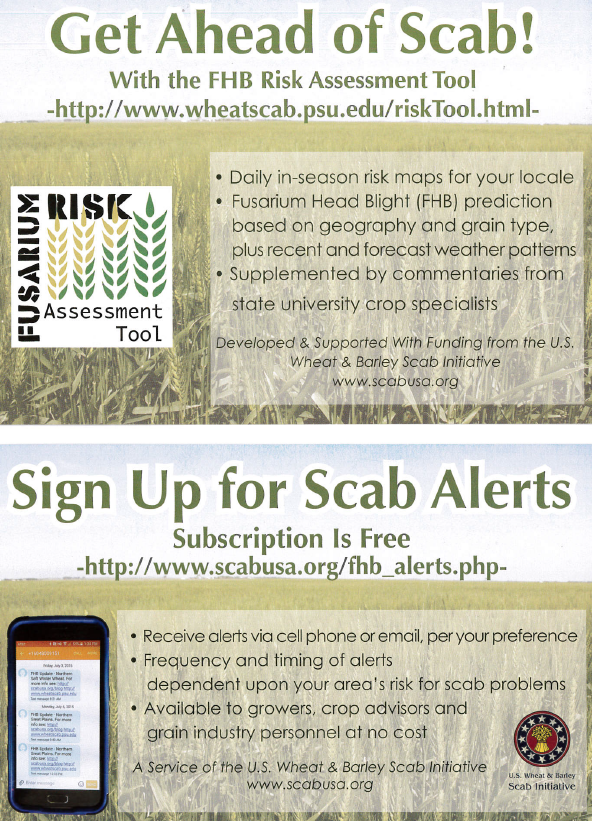
Managing Fusarium Head Blight
Alyssa Koehler, Extension Plant Pathologist
University of Delaware
Andrew Kness, Agriculture Agent
University of Maryland Extension, Harford County
When it comes to controlling Fusarium Head Blight (FHB) and keeping deoxynivalenol (DON) levels low, it is important to have an integrated approach. Considering the disease cycle of FHB (Figure 1), the FHB pathogen (Fusarium graminearum and other Fusarium sp.) is able to grow on crop residues from corn and small grains. In your field rotation plan, try to avoid planting wheat or barley into corn residue; this will help to reduce the amount of initial inoculum in your field. As the pathogen grows on debris, it eventually releases spores that can be rain dispersed or moved through air currents. While the grain is flowering, spores land on the head or anthers, colonize these tissues, and move into the grain head. Once inside the grain, water and nutrient movement is disrupted which results in the bleached florets we associate with FHB (Figure 2). Shriveled and wilted “tombstone” kernels can reduce yield and result in grain contaminated with mycotoxins. DON, also referred to as vomitoxin, is a health hazard to humans and animals. Wheat heads colonized later in development may not show dramatic symptoms, but can have elevated DON.
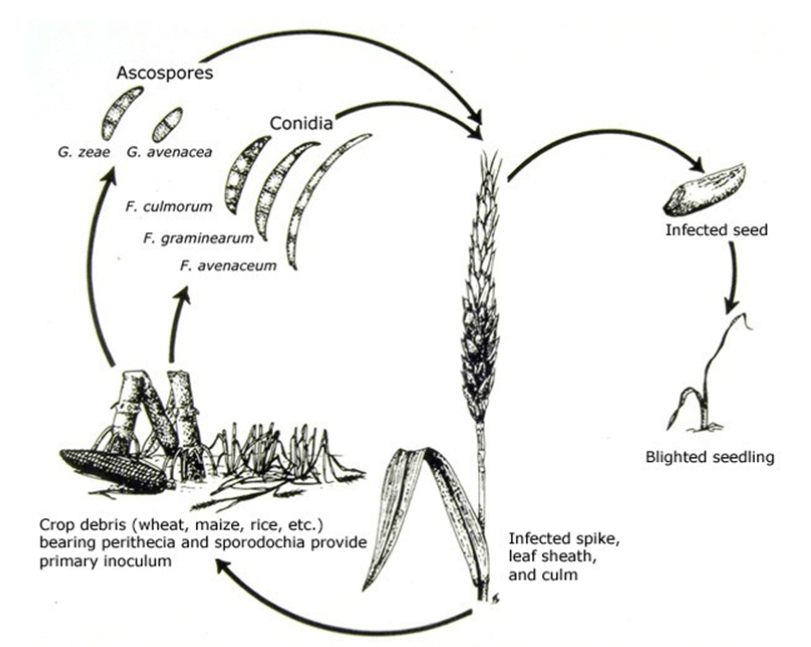
In addition to rotation considerations, seed selection is another important piece of FHB management in wheat. There is no complete host resistance against FHB, but you can select wheat varieties with partial resistance. The University of Maryland sets up a misted nursery to compare FHB index and DON levels across local wheat varieties to aid in variety selection decisions https://scabusa.org/pdfs/UMD-UDE_Misted-Nursery_Factsheet-2018.pdf. Unfortunately, barley does not have any resistance to FHB. At this point in the season, rotation order and variety are established, but you can consider these factors as you plan for next season.
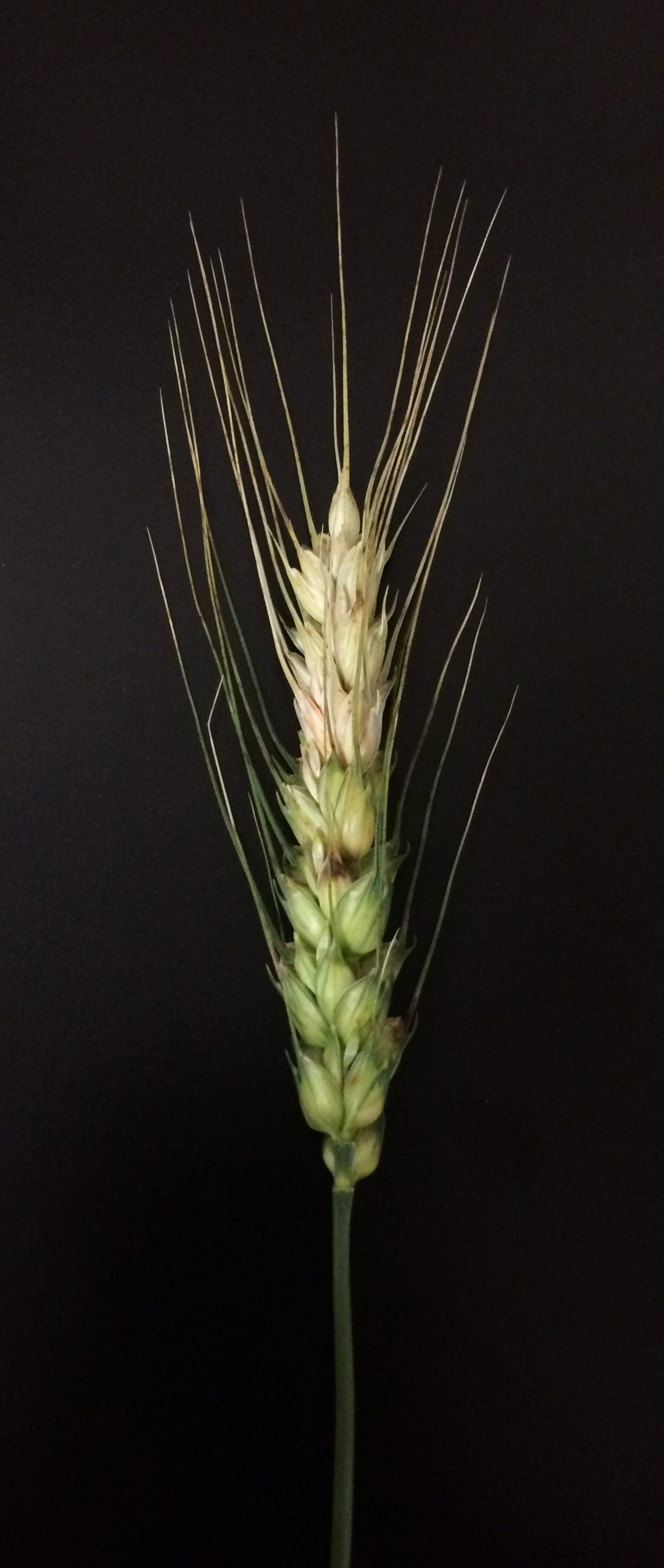
As we think about 2019 in-season disease management strategies, a well-timed fungicide application can help to reduce disease severity and DON levels. It is important to remember that fungicides can help to reduce disease levels and DON (traditionally around 50% reduction on a susceptible variety) but they do not eliminate FHB or DON. To try to maximize the efficacy of fungicides, it is important to apply at the correct timing. Fungicides for FHB are most effective when applied during flowering in wheat and at head emergence in barley. As wheat approaches heading, the Fusarium Risk Assessment Tool (www.wheatscab.psu.edu) is a forecasting model that uses current and predicted weather forecasts to predict FHB risk. This tool is historically about 70% accurate, and can help you assess your risk for developing FHB as your wheat approaches flowering. The pathogen that causes FHB infects through the flower, and rainfall 7 to 10 days prior to flowering increases spore production and risk of infection. Optimal wheat fungicide application is at early flowering (10.5.1) to about 5 days after. For initial signs of wheat heads beginning to flower, look for yellow anthers in the middle of the wheat head. When at least 50% of main stems are flowering, you will want to initiate fungicide applications. As the flowering period continues, anthers will emerge from the top and then the bottom of the wheat heads (Figure 3). Anthers can stay attached after flowering but usually become a pale white.
Method of fungicide application is also important. Flat fan nozzles pointed 90° down are great at covering foliage; however do not do a good job of covering the heads, which is where the product needs to be located. Use nozzles that are angled forward 30-45° down from horizontal (30 degrees is better than 45) or dual nozzles angled both forward and backward. Research has shown that a single forward-angled nozzle or nozzles angled forward and backward allow for significantly more product to contact the head and increase fungicide efficacy. Optimal spray volume is 10 gallons per acre.
Triazole (FRAC group 3) fungicides that are effective on FHB include Caramba (metconazole), Proline (prothioconazole), and Prosaro (prothioconazole + tebuconazole). This year, a new mixed mode of action product is on the market, Miravis Ace. This product contains propiconazole (DMI, FRAC 3) and pydiflumetofen (SDHI, Group 7). On the label, application can begin at Feekes 10.3 through 10.5.2. Although this product can be applied at the earlier timing, preliminary data has shown that optimal FHB control and lower DON levels are achieved at the 10.5.1 timing or a few days beyond this timing. If you spray too early, heads that have not emerged will not be protected by the fungicide application. Rainfall during flowering can increase levels of FHB and delay the ability to get into fields to apply fungicides. The expanded application window of Miravis Ace may offer options if periods of extended rainfall are in the forecast. However, if the weather allows, 10.5.1. to about 5 days after appears to provide the best control to reduced DON. We will be collecting local data on optimal application timing in Georgetown this spring. As a reminder, fungicides containing strobilurins (QoI’s, FRAC 11) should not be used past heading because these fungicides can result in elevated levels of DON.
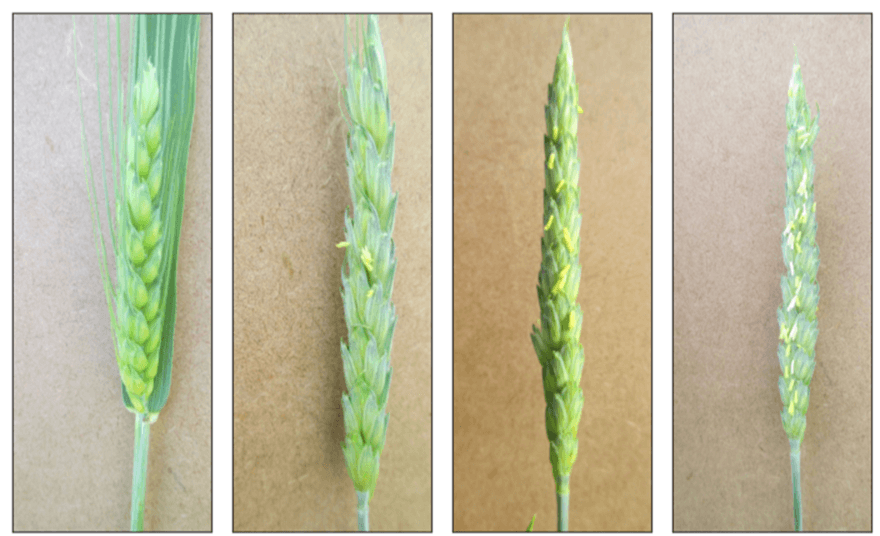
Evaluating Wheat Stands
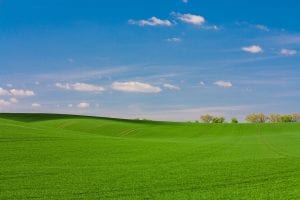
Andrew Kness, Agriculture Agent
University of Maryland Extension, Harford County
The 2018 growing season was a record year in terms of precipitation and is one we would all like to soon forget. However, a soggy fall made it very difficult to seed the 2019 wheat crop and may have lingering effects. Persistent rains delayed planting or forced growers to plant into less-than-ideal field conditions, which may have affected seed establishment and/or plant emergence. As wheat begins to green up and as we approach planting season, it may be a good idea to consider evaluating your wheat stands to help you determine if you should keep the crop for grain vs. a cover crop, consider alternate uses, or terminate it to replant a different crop.
In order to accurately determine wheat stand you will need a yard stick (or any three-foot long stick) and a calculator. Place the stick along a row and count the number of plants in that three-foot section. Record this number and repeat this several times at random locations across the field that are representative of the field as a whole. I would recommend doing this at 15-20 locations to get an accurate average. Take your average and multiply it by four. Divide this number by your row width (in inches). The equation looks like this:

Example:
Plants/ 3 ft. of row: (48+41+38+36+28+51+42+39+48+43+18+29+56+49+45)/15 = 40.7

Alternatively, if your wheat is broadcast or flown on, you can calculate the number of plants per square foot by counting the number of plants in a 1 ft. x 1 ft. square or any other standardized form of measurement as long as you’re consistent (for example, you could use a hula hoop; just calculate it’s area).
To achieve maximum yield potential, stands should be at least 22 plants/sq. ft. You may want to consider alternatives for stands fewer than 12-14 plants per square foot.
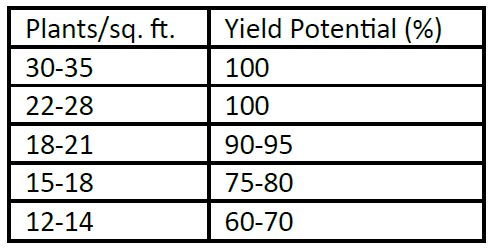
*information from the Penn State Agronomy Guide
Farmers May Apply Commercial Fertilizer to Small Grains Beginning February 15
 Maryland Department of Agriculture press release
Maryland Department of Agriculture press release
The Maryland Department of Agriculture today announced that farmers who planted small grains for harvest last fall may “top dress” these crops with commercial fertilizer beginning February 15, as long as ground conditions remain favorable and in accordance with their nutrient management plans. The determination follows Maryland’s nutrient management regulations and is based on research conducted by University of Maryland plant experts. As a reminder, manure may not be applied to fields until March 1.
Each year, University of Maryland researchers examine soil temperatures and crop growth over the winter to estimate when small grains will emerge from dormancy. According to data collected by University researchers, commercial fertilizer may be safely applied to small grains beginning February 15. At this time, these plants will have absorbed all available nutrients in the soil and will require additional nutrients to keep growing. The University cautions farmers, however, to check individual field conditions and avoid running heavy equipment across saturated soils.
The University recommends split applications of spring nitrogen with the first application occurring on or soon after February 15 and the second application when the crops begin to joint.
For additional information on Maryland’s nutrient application requirements, contact the department’s Nutrient Management Program at 410-841-5959. Farmers with fields that are not suitable for harvest should contact their crop insurance agent for guidance.
Maryland Department of Agriculture Extends Deadline for Planting Cover Crops to November 12

ANNAPOLIS, MD – Due to a late harvest and saturated soil conditions, the Maryland Department of Agriculture has extended the Nov. 5 planting deadline by one week for farmers who have signed up to plant cover crops this fall with the Maryland Agricultural Water Quality Cost-Share (MACS) Program. Farmers now have until Nov. 12 to plant qualifying cover crops of rye, wheat and triticale on their fields.
The extension is only available to farmers who use the following planting methods: no till, conventional, or broadcast with light, minimum or vertical tillage. With the extension, farmers must certify their cover crop with their local soil conservation district within one week of planting and no later than Nov. 19 in order to be reimbursed for associated seed, labor, and equipment costs.
“Extending the planting deadline allows farmers enrolled in our popular Cover Crop program to plant more acres of protective cover crops on their fields this fall in order to control soil erosion, reduce nutrient runoff, build healthy soils, and protect water quality in the Chesapeake Bay and its tributaries,” said Hans Schmidt, the department’s Assistant Secretary of Resource Conservation. “Importantly, the extended forecast calls for mild temperatures which should allow for germination to take place.”
Cover crops are cereal grains that grow in cool weather. They help slow down rainwater runoff during the winter, when the soil would otherwise be exposed, and recycle any nutrients remaining in the soil from the previous summer crop. Cover crops are a key feature in Maryland’s efforts to reduce the amount of nutrients entering the Bay.
Maryland’s Cover Crop program is funded by the Chesapeake Bay Restoration Fund and the Chesapeake and Atlantic Coastal Bays Trust Fund. For more information, farmers should contact their local soil conservation district or the Maryland Agricultural Water Quality Cost-Share Program at 410-841-5864.